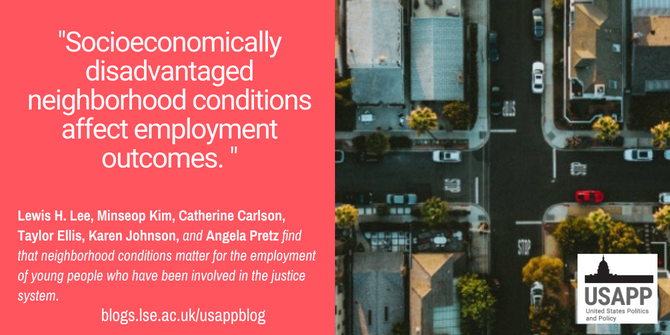Young people who have been involved with the criminal justice system are much more likely to be unemployed than those who have not. In new research, Lewis H. Lee, Minseop Kim, Catherine Carlson, Taylor Ellis, Karen Johnson, and Angela Pretz examined the role of neighborhoods in the employment of justice-involved young adults. They find that young adults who perceive worsening neighborhood conditions tend to work less for formal jobs, whereas a justice-involved young adult who has the same perception is more likely to work more for informal or under-the-table jobs.
Employment is an essential part of people’s lives. In US history, however, understanding the employment of those who have had interactions with the criminal justice system as a defendant (or justice-involved people), has been challenging given that the unemployment rate among formerly justice-involved people is over 27 percent, the highest in the United States. Justice-involved people need stable jobs for the same reasons as the general population; it provides benefits to individuals, including establishing routine activities, financially supporting families, and having better mental/physical health outcomes.
Employment outcomes? Community environment matters
Personal traits or characteristics cannot solely explain why some people from disadvantaged backgrounds have difficulty finding stable jobs. Indeed, access to such employment can be also attributed to adverse neighborhood conditions, which can be theoretically explained by the concept of social isolation. Before the pandemic, the unemployment rate in the US was 10 percent in disadvantaged communities, which was much higher than the overall nationwide rate; plus such disadvantaged communities often become homes for justice-involved people after incarceration. Under these circumstances, questions remain on whether neighborhood conditions affect employment among young adults involved in the justice system; if so, do the patterns of different types of employment (i.e., formal vs. informal jobs) vary with neighborhood conditions?
To expand our understanding of the role of residential context in employment, in new research we examined formerly justice-involved young adults using the most recent data from the Pathways to Desistance study where the study participants were recruited in Philadelphia and Phoenix from 2000 to 2010. We used the employment variables as outcomes measured by total weeks worked for community jobs (i.e., formal jobs) and under-the-table jobs (i.e., informal jobs) in the past year. We separately analyzed these outcomes since justice-involved young people are often unable to secure stable jobs, and frequently engage in informal job markets. We used perceived neighborhood conditions, a main independent variable assessing the environment surrounding the youth’s home, including physical and social disorders, interpreting that higher scores represent a greater degree of physical and social disorder within the community. We also included sociodemographic factors, including perceived employability, mental health symptoms, substance use, gang membership, race, gender, parental socioeconomic status, and education.

Photo by Derek Liang on Unsplash
Justice-involved young adults work less and feel their neighborhoods had mild levels of disorder
First, we find that on average, justice-involved young adults worked less than 20 weeks per year, which were lower than the general population, who worked more than 40 weeks per year on average over the past three decades in the US.
Second, such young adults in our analysis perceived that their neighborhoods had mild degrees of social (e.g., people drunk or passed out, prostitutes on the streets, people smoking crack) and physical (e.g., cigarettes on the street, empty beer bottles on the streets or sidewalks, gang graffiti, needles, or syringes) disorder.
The patterns of different types of employment vary with neighborhood conditions and there are various factors related to employment
Using regression models, we find that young adults (i.e., different persons, or the difference between individuals) who feel that the conditions of their neighborhood are getting worse tend to work less for formal jobs (between effect), whereas a young adult (i.e., the effect on the same person over time) who perceives worsening neighborhood conditions tends to work more for informal or under-the-table jobs (within effect).
For sociodemographic factors, we find that:
- Young adults who had higher perceived employability worked more for community jobs.
- People who used alcohol tended to work more, whereas those had been users of cannabis tended to work less for community jobs and were more likely to work for under-the-table only jobs. Those who used illegal drugs tended to work less for all jobs across community and under-the-table ones.
- A young adult with higher depressive symptoms tended to work less for community jobs, whereas a person with higher anxiety symptoms worked more than his/her counterparts for all jobs.
- An individual involved in gang membership tended to work less for all jobs over time.
- African American and Hispanic young adults were less likely to work for community jobs than their White counterparts.
- Those who enrolled in school before coming to the justice system worked more for all jobs.
Neighborhood stability can mean employment stability
Socioeconomically disadvantaged neighborhood conditions affect employment outcomes. The more active participation in the informal job market by justice-involved young adults mirrors disadvantaged neighborhood environments as a structural barrier where only unstable work can be offered. To assess the effect of neighborhood conditions more accurately on employment, future studies need to use better measured variables for neighborhood conditions and include broader community factors, such as public transportation access, and neighborhood level socioeconomic status by incorporating from census data.
While neighborhood environments are important in obtaining stable employment, we need to think about other critical factors found in this analysis when proposing policies to improve employment outcomes. These factors include developing and implementing plans to increase such young people’s perceived employability; to improve access to mental health services and substance use treatments; to prevent gang membership; to reduce racial disparities in employment; and to promote educational opportunities.
- This article is based on the paper ‘The Association between Perceptions of Neighborhood Conditions and the Employment of Emerging Adults Formerly Involved in the Juvenile Justice System’, in Youth & Society.
Please read our comments policy before commenting.
Note: This article gives the views of the author, and not the position of USAPP – American Politics and Policy, nor the London School of Economics.
Shortened URL for this post: https://bit.ly/3C9jcU8






